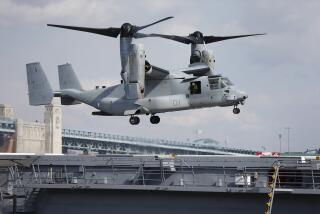House Panel Votes to Kill B-2 After 15 Planes
- Share via
WASHINGTON — A House subcommittee voted Tuesday to kill the B-2 bomber, setting up a battle with the Senate over the future of the controversial $780-million-a-copy Stealth aircraft, congressional sources said.
The procurement subcommittee of the House Armed Services Committee voted 15 to 4 to terminate the B-2 program after completion of the 15 airplanes already authorized. Members of the panel predicted that the full committee and the House will concur, as they did last year.
The B-2 was saved in a compromise between the House and Senate last year, largely on the strength of an endorsement by Sen. Sam Nunn (D-Ga.), the influential chairman of the Senate Armed Services Committee. A Nunn aide said the senator still supports the plane.
A separate House subcommittee, meanwhile, voted 12 to 9 Tuesday to reduce the Administration’s $4.6-billion “Star Wars” funding request to $2.9 billion and to remove all space weapons from the program.
The full House Armed Services Committee is expected to act today on the Administration’s overall $278.3-billion Pentagon spending plan for the fiscal year beginning Oct. 1, a proposed reduction from this year’s $288.3-billion defense budget.
The B-2, which began flight testing last year, is designed to be the nation’s chief long-range nuclear and conventional bomber for the early 21st Century. While it was originally developed to carry only nuclear bombs, the Air Force has begun promoting the plane’s potential use in conventional warfare. The service has noted, for example, that the B-2 could deliver non-nuclear weapons in regional conflicts such as the war against Iraq.
Air Force officials told lawmakers last week that the B-2 has five times the range and 10 times the payload of the F-117 Stealth fighter, which played a pivotal role in the Persian Gulf War.
The Air Force wants to build 75 of the radar-evading planes at a total cost of about $60 billion. To date, $30.8 billion has been spent on the program, officials said.
Critics argue that the plane is too expensive and not needed in an era of diminished superpower tensions. They contend that less costly aircraft in the U.S. inventory can deliver conventional bombs on Third World targets on short notice.
Northrop Corp., the prime contractor on the plane, said that 44,000 workers are employed nationwide on the B-2 project. The program is headquartered at Pico Rivera, Calif., and the planes are assembled at the large Air Force complex at Palmdale. Northrop officials said that the Southern California B-2 work force numbers 12,000.
In its current budget request, the Administration asked for $4.8 billion to build four bombers in 1992 and $4.6 billion to build seven planes in 1993.
More to Read
Get the L.A. Times Politics newsletter
Deeply reported insights into legislation, politics and policy from Sacramento, Washington and beyond. In your inbox twice per week.
You may occasionally receive promotional content from the Los Angeles Times.










